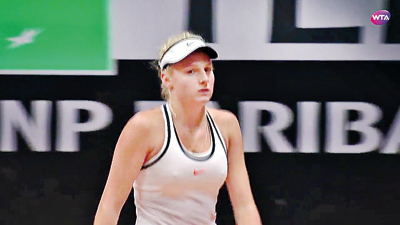Evolve! – the new era formula

Ukraine’s 18-year-old Dayana Yastremska won the WTA event in Hong Kong
‘Evolve’ with own steam and not expect to be assisted, and ‘individualism’, not group comfort, are the present dominating dynamics in becoming a good player. These mechanics are changing the player development approach and implementation.
This year we saw an unprecedented number of new faces in the international circuit. They did not just appear, but won and played in the finals of high profile events. They have evolved using little known methods which, for many, is still a secret formula. It is the new era formula to be an effective player.
Last week, in the WTA event in Hong Kong, Ukraine’s 18-year-old Dayana Yastremska won the title beating Wang Qiang of China, both not well known. These two beat many big names on their way. In the ATP finals in Shanghai, seasoned campaigner Djokovic beat little known 19-year-old Borna Coric of Croatia for the title. Coric, in the previous round, beat Roger Federer. Coric is an unfamiliar name even to a person who follows Tennis with enthusiasm.
Coaching control
With stricter controls in place, where coaches are penalised along with the players equally for cheating in development methods, old roads are shut and new and effective innovations are surfacing. Today, on our soil, most of the methods we have will get a youngster to play Tennis, but will fail in making a ‘Tennis player’. Playing Tennis is a recreational pursuit and the other is surviving international professionalism.
Very small window
The final development span to evolve has also become very short. Many, not even 20 years of age, are in the top 100 in the world. Much of the militarised group methods are being shelved, as they burn and injure the players, and also curtail natural evolution. The actual window a women player has now to achieve the final phase of competition Tennis is between 16 to 18. Both inclusive, it is a mere 3 years.
These 3 years will have to accommodate a player to evolve with effective skill, physical and tactical requirements. It is not a tall order in time or, in achievement, with correct methods. Player enthusiasm and responsibility will see a player through it with comfortable ease.
Guides
With players having to play a greater part, competition exposure will weigh more than the coach’s input. Excess coach’s input, I have noticed, makes the player dependent on external factors to perform on court. In other words, when they step out on to the competition platform, their comfort zone shrinks. A weakness, opponents can exploit very quickly.
The other help to evolve could come from past players. Although they have left the game, their instruction on instincts to sense and survive competition, I always found it to be valuable to the juniors. As past players, they will use intense set of vocabulary, expressions and analysis which will be unfamiliar to laymen. Having them closer is a valuable assistance to the juniors.
Evolved games of elites
Any analysis of the top 10 in the world, in either gender, over the last 2 decades, is bound to show that no 2 players are alike. It is a very sign to say that players cannot be developed on a rigid code. They have to come through a ‘comfort zone’ process. This is where a good coach will know when to stop telling the player and let them evolve. At a certain stage, even the best coach cannot do anything more to a player. It is the point at which player has to take over and evolve.
In the case of well-known player Steffi Graf, her coach Pavel Slozil shocked the world with the announcement of termination with Graf at her peak. It was considered one of the most successful player-coach relationships. After that, Steffi Graf on her own, went make the most incredible record in the history of women’s Tennis. She won Grand Slam tournaments many times.
There comes a point in time one has to learn from others. In the same vein, there comes a point when a player has to evolve to survive. Nothing external will provide that lift.
WTA Final – Singapore
 Naomi Osaka of Japan is the second Asian ever to win a Grand-Slam event. This will be her maiden appearance in the WTA finals. The WTA Singapore event from tomorrow is for the best 8 players of the world. It has a total prize money of US$ 7 million. This means, even a qualifier will go home with good money. Romania’s Simona Halep’s early and mid-season performances has placed her to be the No.1 WTA player. There is a financial consideration for that too.
Naomi Osaka of Japan is the second Asian ever to win a Grand-Slam event. This will be her maiden appearance in the WTA finals. The WTA Singapore event from tomorrow is for the best 8 players of the world. It has a total prize money of US$ 7 million. This means, even a qualifier will go home with good money. Romania’s Simona Halep’s early and mid-season performances has placed her to be the No.1 WTA player. There is a financial consideration for that too.
Poland’s Caroline Wozniacki has been a consistent performer throughout the year. Her game of ‘counter punching’, along with her ability to cover court, and to ‘hang in’, makes her a good performer. No one should underestimate Wozniacki.
The others are Angelique Kerber and Julia Georges from Germany, Korolina Pliskova and Petra Kvitova of Czech Republic, Sloane Stephens from the USA and Elina Svitolina from Ukraine. The outsiders with 3,740 ranking points are Belgium’s Kiki Bertens and Anastasjia Sevastova of Latvia. The event, apart from staging good Tennis, will also parade the players in fashionable dresses. Then they will get down to their expertise, which is playing winning Tennis.
George Paldano, Former int. player; Accredited Coach of German Federation; National coach Sri Lanka & Brunei, Davis-Cup, Federation Cup captain/coach– contact 94 77 544 8880 geodano2015@gmail.com –


